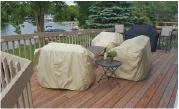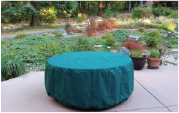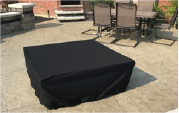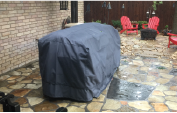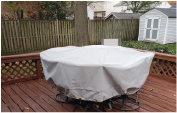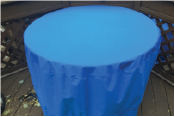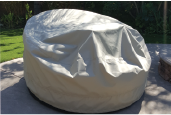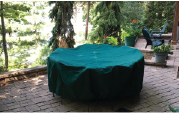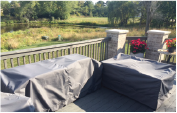
If you've ever left your patio furniture outside during a surprise rainstorm or a dust storm, you know the pain of cleaning soggy cushions. Outdoor furniture is built to handle a bit of weather, but it won’t last long without proper protection. That’s where outdoor chair covers come in and choosing the right fabric for them can make all the difference.
So, what’s the best fabric for outdoor chair covers? This blog is your ultimate guide to comparing the most common fabrics used in outdoor patio furniture covers. We’ll break it down so clearly that you can easily pick the right cover.
Why Does Outdoor Covers Fabric Choice Matter?
The whole point of a cover is protection. However, not all fabrics are worth buying. Some are water-resistant but not breathable, which means you’ll get mold. Others are breathable but flimsy, tearing with the slightest wind. Some last only one season while others go for years without a single rip.
If you pick the wrong one, you’re not just replacing a cover, you’re slowly destroying your furniture. This is why, choosing the right fabric is non-negotiable.
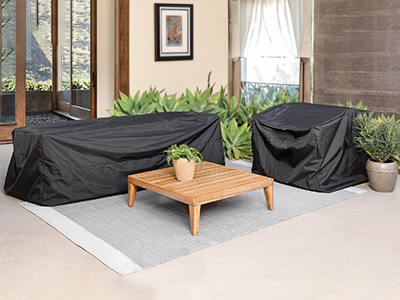
Common Materials for Outdoor Patio Furniture Covers
Polyester
Polyester is a synthetic fabric that’s strong, lightweight, and often treated with water-resistant coatings. It is best for mild to moderate climates. If your outdoor space doesn’t get extreme weather, polyester works great for everyday use. You can look for versions with extra UV and waterproof coatings for added durability.
Pros:
- Affordable
- Lightweight and easy to handle
- Often treated for UV resistance and waterproofing
Cons:
- Can degrade under intense sunlight over time
- Not always breathable (can cause mold if not ventilated)
Vinyl (PVC)
It’s a plastic-based material that offers maximum water resistance. Works well when water is your main concern but only if you add vents or store cushions separately. Don’t use it in humid climates without airflow. You can easily use it in wet, rainy environments where you need water protection.
Pros:
- 100% waterproof
- Great for rain, snow, or coastal areas
- Easy to clean with just a wipe-down
Cons:
- Not breathable (moisture gets trapped inside)
- Can crack in freezing temperatures
- Not eco-friendly
Canvas
A thick woven fabric made of cotton or a cotton-synthetic blend. The best part is that covers made from this fabric are very tough and reliable. They come in handy when environments get rough and where durability matters the most. Make sure it’s stored dry or else it will get moldy.
Pros:
- Very durable
- Often treated for water and UV resistance
- Breathable
Cons:
- Heavier and bulkier than other fabrics
- Can absorb moisture if not treated properly
Solution-Dyed Acrylic
Acrylic fibers are dyed before being woven resulting in deep, lasting color and performance. If you are area gets a lot of sun. You should definitely go for this. Plus, it’s great for design-conscious homeowners who want both performance and aesthetics.
Pros:
- Superior UV resistance (colors don’t fade)
- Water-resistant
- Breathable
- Mildew-resistant
Cons:
- Expensive
- Limited availability of cheaper products
Completely worth the money if you care about longevity and appearance. Ideal for premium outdoor patio table chair covers.
Olefin (Polypropylene)
A synthetic fiber known for its strength, fade resistance, and low moisture absorption. Best for budget buyers who still want solid protection. It’s great for seasonal use or for secondary patio setups.
Pros:
- Water-resistant
- UV resistant
- Inexpensive
- Quick-drying
Cons:
- Not as soft or luxurious in appearance
- May become stiff over time in cold weather
Pro Tips Before You Buy
- Always measure your furniture. A great fabric is useless if it doesn’t fit.
- Check for vents and air pockets. Especially if using vinyl or polyester.
- Don’t assume expensive means better. Olefin and polyester can outperform pricier options in the right conditions.
- Store covers properly. Even the best outdoor chair covers won’t last if they’re crumpled in a damp garage.
_1.jpg)
What to Avoid When Buying Outdoor Chair Covers?
Now that you know what to look for, let’s talk about what to avoid. Many people waste money on covers that don’t do the job.
No UV Protection Mentioned
If the packaging or product description doesn’t talk about UV resistance, skip it. The sun destroys untreated fabrics. Faded covers = exposed furniture.
Cheap-Looking Seams or Stitching
Check the corners, zippers, and handles. Thin stitching will fall apart after a season or two. Go for double-stitched seams and reinforced handles.
No Air Vents
This is a silent killer. Without ventilation, moisture gets trapped and turns your furniture into a mold farm. Make sure your outdoor chair covers have vents, flaps, or breathable panels.
Bottom Line
The fabric you choose for your outdoor patio chair and table covers matters more than you think. It’s the difference between furniture that lasts a decade and furniture that gets tossed after one summer.
Invest smart, not hard. Pick the fabric that fits your needs, not just your budget. When in doubt, choose breathability and UV resistance over price tags. So, read the label and never underestimate the power of a well-made outdoor patio furniture cover.

_1.png)
